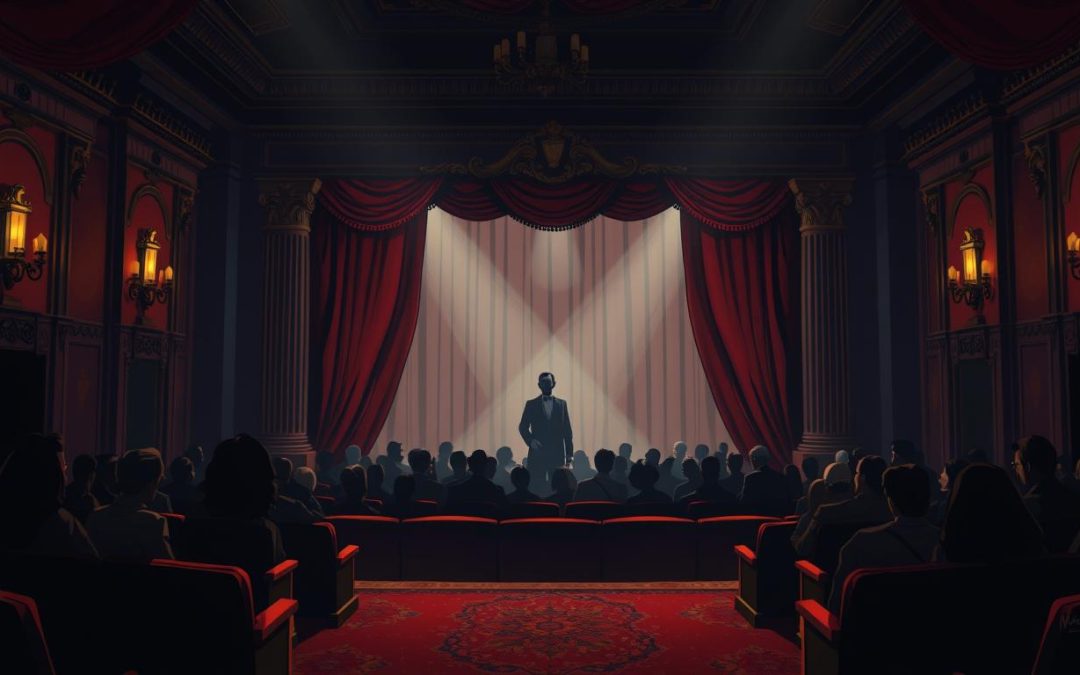On a spring evening in 1865, American history took a dramatic turn. President Abraham Lincoln, celebrating the Union’s victory in the Civil War, went to Ford’s Theatre in Washington, D.C. He had no idea this night would be his last.
At 10:15 PM, as everyone laughed at “Our American Cousin,” John Wilkes Booth, a Confederate supporter, entered the presidential box. He quickly fired a .44 caliber derringer, hitting Lincoln in the back of the head.
The nation was shocked by the news. Lincoln, who had led the country through its darkest time, passed away at 7:22 AM on April 15, 1865. His death led to the biggest manhunt in U.S. history, ending with Booth’s capture and death on April 26.
This tragic event happened just days after the Civil War ended. It cast a long shadow over the Reconstruction era. Lincoln’s death had lasting effects on American politics and society for many years.
Key Takeaways
- Abraham Lincoln was assassinated on April 14, 1865, at Ford’s Theatre.
- John Wilkes Booth, the assassin, was a famous actor and Confederate sympathizer.
- Lincoln died at 7:22 AM on April 15, 1865, after being shot the previous night.
- The assassination was part of a larger conspiracy targeting government officials.
- Booth was killed during his capture on April 26, 1865.
- Four co-conspirators were found guilty and hanged on July 7, 1865.
- Lincoln’s death had profound impacts on Reconstruction and American politics.
The Fateful Night at Ford’s Theatre
On April 14, 1865, Ford’s Theatre in Washington D.C. was buzzing with excitement. The Civil War was ending, and the city was full of hope. President Abraham Lincoln, in his second term, chose to see “Our American Cousin.”
The Play: “Our American Cousin”
“Our American Cousin” was a hit comedy back then. Tom Taylor wrote it, and it had been a big success in New York. By 1865, it had been performed almost 500 times in London.
Lincoln’s Arrival and Seating
When Lincoln arrived at Ford’s Theatre, everyone knew he was there. The violin played “Hail to the Chief.” He sat in the Presidential Box with Major Henry Rathbone and his fiancée, Clara Harris. About 1,700 people were in the theatre that night.
The Atmosphere in Washington D.C.
Washington D.C. was filled with hope and a bit of fear. The Civil War was almost over, but no one knew what the future held. John Wilkes Booth, a 26-year-old actor, had a dark plan for that night.
| Detail | Fact |
|---|---|
| Play | “Our American Cousin” |
| Venue | Ford’s Theatre |
| Date | April 14, 1865 |
| Audience Size | ~1,700 people |
| Lincoln’s Term | One month into second |
John Wilkes Booth: The Man Behind the Assassination
John Wilkes Booth was born on May 10, 1838, in Bel Air, Maryland. He was a famous actor and had strong Confederate sympathies. He was the ninth of ten children, with a family known for their acting talents. His father, Junius Brutus Booth, was a well-known British Shakespearean actor.
Booth started acting at 17 in 1855. By the late 1850s, he was making around $20,000 a year. He toured major cities like New York, Boston, and New Orleans. In 1862, he starred in Richard III in New York City, making him a national star.
Despite his fame, Booth had strong anti-Union feelings. He joined the pro-Confederate Knights of the Golden Circle in Baltimore in 1860. When the Civil War started in 1861, he openly supported the South’s secession.
| Event | Date |
|---|---|
| Birth | May 10, 1838 |
| Stage Debut | August 14, 1855 |
| Lincoln Assassination | April 14, 1865 |
| Death | April 26, 1865 |
Booth’s support for the Confederacy grew over time. In autumn 1864, he started planning to kidnap President Lincoln. This plan turned into an assassination, leading to the tragic event at Ford’s Theatre on April 14, 1865.
The Assassination Plot Unveiled
The lincoln assassination plot started as a bold plan to kidnap President Abraham Lincoln. John Wilkes Booth, a 26-year-old actor and Confederate supporter, came up with the idea in 1864. He wanted to use Lincoln to force the Union to swap prisoners, helping the Confederate cause.
Initial Plans to Kidnap Lincoln
Booth gathered a group of conspirators for his daring plan. These included Samuel Arnold, George Atzerodt, David Herold, Michael O’Laughlen, Lewis Powell, and John Surratt. Each had a role, from gathering info to carrying out the kidnapping.
Shift to Assassination
As the Confederacy’s defeat seemed inevitable, Booth’s plan turned deadly. The kidnapping plan turned into a plot to assassinate. He aimed to kill Vice President Andrew Johnson and Secretary of State William H. Seward too, to cripple the Union’s leadership.
Booth’s Co-conspirators
Three key players were part of Booth’s new plan:
- Lewis Powell, a 20-year-old former Confederate soldier, was to kill Seward
- David Herold, a 22-year-old pharmacist’s assistant, was to guide Powell
- George Atzerodt, a 29-year-old German immigrant, was to kill Vice President Johnson
On April 14, 1865, the conspirators put their plan into action. Booth shot Lincoln at Ford’s Theatre, but the others failed. Powell tried to kill Seward but missed, and Atzerodt didn’t go through with his part of the plan.
April 14, 1865, Lincoln’s Assassination: The Moment that Changed America
On April 14, 1865, a tragic event shook the foundations of American history. President Abraham Lincoln, aged 56, attended a performance of “Our American Cousin” at Ford’s Theatre. The atmosphere in Washington D.C. was celebratory, with public buildings illuminated to mark recent Union victories.
At approximately 10:15 PM, John Wilkes Booth entered the Presidential Box. In a shocking act that would forever alter the course of the nation, Booth fired a single shot from his derringer pistol, striking Lincoln in the head. The theatre, with a capacity of 1900, held about 1700 spectators that fateful night.
“She won’t think anything about it.” – Abraham Lincoln’s last words
After the shooting, Booth struggled with Major Rathbone, slashing him with a knife. The assassin then leaped from the box to the stage, breaking his leg in the process. Shouting “Sic semper tyrannis!” Booth escaped through the theatre’s back door.
Lincoln’s assassination marked a pivotal moment in American history. The nation’s mood shifted from jubilation over the Civil War’s end to profound grief. The funeral procession, stretching three miles long, took over two hours to pass a single point, with thousands of mourners lining Pennsylvania Avenue.
| Event | Date | Significance |
|---|---|---|
| Lincoln’s Assassination | April 14, 1865 | Changed the course of Reconstruction |
| Lincoln’s Death | April 15, 1865 | National day of mourning |
| Secret Service Creation | April 14, 1865 | Initially to prevent counterfeiting |
The Aftermath of the Shooting
The moments after Lincoln’s shooting were chaotic. People around him acted fast to save his life.
Dr. Charles Leale’s Immediate Response
Dr. Charles Leale, a young Army surgeon, was at Ford’s Theater. He quickly helped Lincoln. His fast action was very important.
Moving Lincoln to the Petersen House
Dr. Leale knew Lincoln’s injury was serious. He ordered the president to be moved. They took him to the Petersen House, a quiet place for doctors to work.
Lincoln’s Final Hours
At the Petersen House, doctors tried to save Lincoln. But he stayed in a coma. The nation waited anxiously as news of the assassination spread. Sadly, Lincoln died at 7:22 AM on April 15, 1865. He was the first U.S. president to be killed by an assassin.
| Event | Time | Location |
|---|---|---|
| Assassination | 10:15 PM, April 14, 1865 | Ford’s Theater |
| Dr. Leale’s Response | Immediately after shooting | Ford’s Theater |
| Move to Petersen House | Approximately 10:30 PM | Across from Ford’s Theater |
| Lincoln’s Death | 7:22 AM, April 15, 1865 | Petersen House |
Parallel Attacks: The Assault on Secretary Seward
On April 14, 1865, John Wilkes Booth aimed for President Lincoln. Meanwhile, Lewis Powell, also known as Lewis Payne, attacked Secretary William Henry Seward. Powell forced his way into Seward’s home, causing chaos and injuries.
The attack left Seward’s household in chaos. Frederick Seward, the Secretary’s son, suffered severe head injuries. He was in a coma for 60 hours. Other victims included George Foster Robinson, Major Augustus H. Seward, and Emrick W. Hansell.
Thanks to a metal collar from a recent accident, William Henry Seward survived. Dr. Verdi treated his face and neck wounds. Later, Surgeon General James K. Barnes helped with the medical care.
| Victim | Injury | Recovery Time |
|---|---|---|
| William Henry Seward | Face and neck gashes | Fully recovered by April 25, 1865 |
| Frederick Seward | Severe head injuries | 60-hour coma, required surgery |
The media wrongly reported the deaths of William and Frederick Seward. This caused public panic. Despite their injuries, both men survived. However, the Seward family faced ongoing health issues.
Frances Seward died on June 21, 1865. Her daughter Fanny passed away 16 months later. Lewis Powell was caught and executed for his attempt on Secretary Seward. This marked a dark chapter in American history.
The Manhunt for John Wilkes Booth
The hunt for John Wilkes Booth started right after President Lincoln’s death on April 14, 1865. Union troops quickly moved to southern Maryland and Virginia to catch the assassin. Over 1,000 soldiers joined the search, making it a huge effort in American history.
Booth’s Escape Route
Booth’s escape was through tough terrain. He and David Herold hid in Zekiah Swamp for four days. They almost got caught as Union soldiers got closer. The government offered a big reward for Booth, Herold, and another suspect, making the search even more intense.
Public Reaction and Pursuit
The nation was shocked. People were outraged when they heard about Lincoln’s death. Even civilians joined the search, including the Alexandria Fire Department. Sadly, a naval accident during the search killed 87 people, showing how urgent and chaotic it was.
Capture and Death of Booth
On April 26, 1865, Union soldiers found Booth on a Virginia farm. As the barn he was in caught fire, Booth came out. Boston Corbett, a soldier, shot him in the neck. Booth’s death ended a 12-day hunt that had the whole nation on edge.
| Event | Date | Details |
|---|---|---|
| Lincoln’s Assassination | April 14, 1865 | Booth shoots Lincoln at Ford’s Theatre |
| Manhunt Begins | April 15, 1865 | Nearly 1,000 Union soldiers deployed |
| Zekiah Swamp Hideout | April 16-20, 1865 | Booth and Herold evade capture for 4 days |
| Booth’s Death | April 26, 1865 | Shot by Boston Corbett on a Virginia farm |
The Fate of the Co-conspirators
The conspirators behind Lincoln’s assassination were quickly brought to justice. Four of Booth’s helpers were tried by a military court. They were executed on July 7, 1865. Lewis Powell, who attacked Secretary of State William Seward, and Mary Surratt, the first woman executed by the U.S., were among them.
The others faced different outcomes. Some got life sentences, while others were in prison for shorter times. One even escaped conviction. Here’s a table showing what happened to them:
| Fate | Number of Conspirators |
|---|---|
| Executed by hanging | 5 |
| Life imprisonment | 3 |
| Pardoned | 3 |
| Short prison sentence | 1 |
| Not convicted | 1 |
George Atzerodt was supposed to kill Vice President Andrew Johnson but didn’t. His cowardice led to his hanging. David Herold, who helped Booth escape, also faced the same end.
The trials and executions of the conspirators closed a dark chapter in U.S. history. Their actions had a lasting impact on the nation, leaving a deep scar in its memory.
Impact on the Nation and Reconstruction
The assassination of Lincoln had a huge impact on America. The nation went into deep mourning, trying to deal with the loss of their leader. This event started the reconstruction era, a time of big changes in politics and society.
National Mourning
Americans mourned deeply for their president. Buildings were covered in black, and thousands watched as Lincoln’s funeral train passed by. This shared grief brought the nation together, still healing from the Civil War.
Political Consequences
Lincoln’s death changed the course of the reconstruction era. Vice President Andrew Johnson took over, taking a softer stance on the South. This move caused disagreements with Congress and shaped the nation’s policies after the war.
Legacy of Lincoln’s Death
Lincoln’s assassination made him a symbol of the Union. His death turned him into a martyr, influencing politics for many years. The reconstruction era, from 1865 to 1877, saw important laws like the 14th Amendment. This amendment gave citizenship and equal rights to all born in the United States.
| Event | Date | Significance |
|---|---|---|
| Lincoln’s Assassination | April 14, 1865 | Triggered national mourning, altered Reconstruction plans |
| Andrew Johnson’s Presidency | April 15, 1865 | Implemented lenient measures towards the South |
| Reconstruction Acts | 1867 | Placed Southern states under military occupation |
| 14th Amendment Ratification | 1868 | Granted citizenship and equal protection to all U.S.-born persons |
Lincoln’s Premonitions and Final Days
Abraham Lincoln’s last days were filled with strange dreams and visions. He was known for his deep interest in dream meanings. On April 14, 1865, he shared a haunting dream with his cabinet.
Lincoln dreamed of sailing to an unknown shore. He said this dream came before big events in the Civil War.
After his death, people became fascinated with his dreams. Ward Hill Lamon, his former law partner, told a story. He said Lincoln dreamed of his own corpse in the White House.
This story was shared nearly 20 years after Lincoln’s death. It sparked a debate among historians about its truth.
On the morning of his death, Lincoln seemed cheerful. He talked about his dream with his wife, Mary. He didn’t know the tragedy that would happen that evening.
His love for Shakespeare’s Macbeth added irony to his death. This play was his favorite, which he called “wonderful.”
Lincoln’s dreams and premonitions became part of American folklore. They inspired Walt Whitman’s “O Captain! My Captain!” and sparked discussions about Lincoln’s fate.
The mix of Lincoln’s visions and his assassination on April 14, 1865, still fascinates many. It’s a key part of American history.
FAQ
What play was being performed at Ford’s Theatre when Lincoln was assassinated?
Lincoln was at Ford’s Theatre watching “Our American Cousin” on April 14, 1865.
Who was John Wilkes Booth, and what was his motive for assassinating Lincoln?
John Wilkes Booth was a well-known actor and a strong Confederate supporter. He hated the Union and wanted to help the South. He first planned to kidnap Lincoln but later decided to assassinate him.
What happened to Booth after he assassinated Lincoln?
After shooting Lincoln, Booth rode off to southern Maryland and then into Virginia. A huge search for him began. He was found on April 26, 1865, at a farm near Bowling Green, Virginia. Booth was killed in a standoff with Union soldiers.
What were the fates of Booth’s co-conspirators in the assassination plot?
Four of Booth’s helpers – Lewis Powell, George Atzerodt, David Herold, and Mary Surratt – were tried and hanged on July 7, 1865. Others got prison sentences.
What was the impact of Lincoln’s assassination on the nation and Reconstruction?
Lincoln’s death caused a long period of mourning and changed politics. Vice President Andrew Johnson took over and was softer on the South than Lincoln. Lincoln became a symbol of the Union’s sacrifice.
Were there any reports of Lincoln having premonitions about his death?
Yes, Lincoln had dreams and feelings about his death before it happened. He dreamed of finding a dead body in the White House. He also had dreams before big events in the Civil War.



